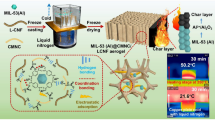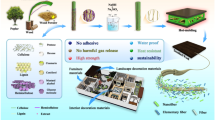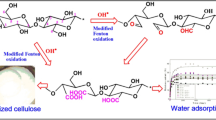Abstract
Nanofibrillated cellulose (NFC) aqueous suspensions were produced from once-dried bisulfite softwood pulp using enzymatic or 2,2,6,6-tetramethylpiperidine-1-oxyl (TEMPO)-mediated oxidation pretreatments, followed by wet grinding, as an ultimate fibrillation technique. Two commercial enzyme solutions: cellulase, with the major activity of endoglucanase and exoglucanase, and monocomponent endoglucanase, were compared to facilitate the nanofibrils isolation from cellulose fibers. The influence of their concentrations, as well as the other processing conditions, was analyzed. The morphology of the produced NFC was characterized using optical microscopy, atomic force microscopy (AFM), field emission gun-scanning electron microscopy (FEG-SEM), and morphological fiber analyzer (MorFi). Nanofibrils with a wide size distribution were produced. The average lateral dimensions of 12 ± 7 nm for the most disintegrated enzymatically hydrolyzed NFC and 4 ± 2 nm for TEMPO-oxidized NFC were determined from the AFM height images. The degree of polymerization (DP) decreased and the crystallinity index (CI) increased with an increase of the concentration of both enzyme solutions. TEMPO-oxidation did not have a significant impact on the cellulose CI; however, the DP was strongly affected. The monocomponent endoglucanase solution was found to have a better effect on the nanofibrils isolation rather than their depolymerization.







Similar content being viewed by others
References
Klemm D, Kramer F, Moritz S et al (2011) Nanocelluloses: a new family of nature-based materials. Angew Chem Int Ed 50:5438–5466. doi:10.1002/anie.201001273
Turbak AF, Snyder FW, Sandberg KR (1983) Microfibrillated Cellulose, a New Cellulose Product: Properties, Uses, and Commercial Potential. In: Sarko A (ed) Proceedings of the Ninth Cellulose Conference, Appl Polym Symp, 37. Wiley, New York, pp 815–827
Turbak AF, Snyder FW, Sandberg KR (1983) Microfibrillated cellulose. U.S. Patent No. 4,374,702
Isogai A (2013) Wood nanocelluloses: fundamentals and applications as new bio-based nanomaterials. J Wood Sci 59:449–459. doi:10.1007/s10086-013-1365-z
Lavoine N, Desloges I, Dufresne A, Bras J (2012) Microfibrillated cellulose—Its barrier properties and applications in cellulosic materials: a review. Carbohydr Polym 90:735–764. doi:10.1016/j.carbpol.2012.05.026
Siró I, Plackett D (2010) Microfibrillated cellulose and new nanocomposite materials: a review. Cellul 17:459–494. doi:10.1007/s10570-010-9405-y
Stelte W, Sanadi AR (2009) Preparation and characterization of cellulose nanofibers from two commercial hardwood and softwood pulps. Ind Eng Chem Res 48:11211–11219. doi:10.1021/ie9011672
Shackford LD (2003) A Comparison of Pul** and Bleaching of Kraft Softwood and Eucalyptus Pulps. In: 36th International pulp and paper congress and exhibition, São Paulo, Brazil
Wang QQ, Zhu JY, Gleisner R et al (2012) Morphological development of cellulose fibrils of a bleached eucalyptus pulp by mechanical fibrillation. Cellul 19:1631–1643. doi:10.1007/s10570-012-9745-x
Herrick FW, Casebier RL, Hamilton JK, Sandberg KR (1983) Microfibrillated Cellulose: morphology, and accessibility. In: Sarko A (ed) Proceedings of the Ninth Cellulose Conference, Appl Polym Symp, 37. Wiley, New York, pp 797–813
Henriksson M, Henriksson G, Berglund LA, Lindström T (2007) An environmentally friendly method for enzyme-assisted preparation of microfibrillated cellulose (MFC) nanofibers. Eur Polym J 43:3434–3441. doi:10.1016/j.eurpolymj.2007.05.038
Svagan AJ, Azizi Samir MAS, Berglund LA (2007) Biomimetic polysaccharide nanocomposites of high cellulose content and high toughness. Biomacromol 8:2556–2563. doi:10.1021/bm0703160
Nakagaito AN, Yano H (2004) The effect of morphological changes from pulp fiber towards nano-scale fibrillated cellulose on the mechanical properties of high-strength plant fiber based composites. Appl Phys A 78:547–552. doi:10.1007/s00339-003-2453-5
Pääkkö M, Ankerfors M, Kosonen H et al (2007) Enzymatic hydrolysis combined with mechanical shearing and high-pressure homogenization for nanoscale cellulose fibrils and strong gels. Biomacromol 8:1934–1941. doi:10.1021/bm061215p
Zimmermann T, Pöhler E, Geiger T (2004) Cellulose fibrils for polymer reinforcement. Adv Eng Mater 6:754–761. doi:10.1002/adem.200400097
Spence KL, Venditti RA, Rojas OJ et al (2011) A comparative study of energy consumption and physical properties of microfibrillated cellulose produced by different processing methods. Cellul 18:1097–1111. doi:10.1007/s10570-011-9533-z
Taniguchi T, Okamura K (1998) New films produced from microfibrillated natural fibres. Polym Int 47:291–294. doi:10.1002/(SICI)1097-0126(199811)47:3<291:AID-PI11>3.0.CO;2-1
Iwamoto S, Nakagaito AN, Yano H (2007) Nano-fibrillation of pulp fibers for the processing of transparent nanocomposites. Appl Phys A 89:461–466. doi:10.1007/s00339-007-4175-6
Bulota M, Kreitsmann K, Hughes M, Paltakari J (2012) Acetylated microfibrillated cellulose as a toughening agent in poly (lactic acid). J Appl Polym Sci 126:E449–E458. doi:10.1002/app.36787
Jonoobi M, Mathew AP, Oksman K (2012) Producing low-cost cellulose nanofiber from sludge as new source of raw materials. Ind Crop Prod 40:232–238. doi:10.1016/j.indcrop.2012.03.018
Spence KL, Venditti RA, Habibi Y et al (2010) The effect of chemical composition on microfibrillar cellulose films from wood pulps: mechanical processing and physical properties. Bioresour Technol 101:5961–5968
Tejado A, Alam MN, Antal M et al (2012) Energy requirements for the disintegration of cellulose fibers into cellulose nanofibers. Cellul 19:831–842. doi:10.1007/s10570-012-9694-4
Tangnu SK (1982) Process development for ethanol production based on enzymatic hydrolysis of cellulosic biomass. Process Biochem 17:36–45
Siqueira G, Tapin-Lingua S, Bras J et al (2010) Morphological investigation of nanoparticles obtained from combined mechanical shearing, and enzymatic and acid hydrolysis of sisal fibers. Cellul 17:1147–1158. doi:10.1007/s10570-010-9449-z
Qing Y, Sabo R, Zhu JY et al (2013) A comparative study of cellulose nanofibrils disintegrated via multiple processing approaches. Carbohydr Polym 97:226–234. doi:10.1016/j.carbpol.2013.04.086
Turon X, Rojas OJ, Deinhammer RS (2008) enzymatic kinetics of cellulose hydrolysis: a QCM-D study. Langmuir 24:3880–3887. doi:10.1021/la7032753
Rosgaard L, Pedersen S, Langston J et al (2007) Evaluation of minimal trichoderma reesei cellulase mixtures on differently pretreated barley straw substrates. Biotechnol Prog 23:1270–1276. doi:10.1021/bp070329p
Zhou S, Ingram LO (2000) Synergistic hydrolysis of carboxymethyl cellulose and acid-swollen cellulose by two endoglucanases (CelZ and CelY) from Erwinia chrysanthemi. J Bacteriol 182:5676–5682. doi:10.1128/JB.182.20.5676-5682.2000
Saito T, Nishiyama Y, Putaux J-L et al (2006) Homogeneous suspensions of individualized microfibrils from TEMPO-catalyzed oxidation of native cellulose. Biomacromol 7:1687–1691. doi:10.1021/bm060154s
Bäckström M, Bolivar S, Paltakari J (2012) Effect of ionic form on fibrillation and the development of the fibre network strength during the refining of the kraft pulps. O Papel 73:57–65
Saito T, Hirota M, Tamura N et al (2009) Individualization of nano-sized plant cellulose fibrils by direct surface carboxylation using TEMPO catalyst under neutral conditions. Biomacromol 10:1992–1996. doi:10.1021/bm900414t
Spinu M, Santos ND, Moigne NL, Navard P (2011) How does the never-dried state influence the swelling and dissolution of cellulose fibres in aqueous solvent? Cellul 18:247–256. doi:10.1007/s10570-010-9485-8
Saito T, Kimura S, Nishiyama Y, Isogai A (2007) Cellulose nanofibers prepared by TEMPO-mediated oxidation of native cellulose. Biomacromol 8:2485–2491. doi:10.1021/bm0703970
Segal L, Creely JJ, Martin AE, Conrad CM (1959) An empirical method for estimating the degree of crystallinity of native cellulose using the X-Ray diffractometer. Text Res J 29:786–794. doi:10.1177/004051755902901003
Zhu JY, Sabo R, Luo X (2011) Integrated production of nano-fibrillated cellulose and cellulosic biofuel (ethanol) by enzymatic fractionation of wood fibers. Green Chem 13:1339–1344. doi:10.1039/C1GC15103G
Park S, Baker JO, Himmel ME et al (2010) Cellulose crystallinity index: measurement techniques and their impact on interpreting cellulase performance. Biotechnol Biofuels 3:10. doi:10.1186/1754-6834-3-10
Gama FM, Mota M (1997) Enzymatic hydrolysis of cellulose (I): relationship between kinetics and physico-chemical parameters. Biocatal Biotransform 15:221–236. doi:10.3109/10242429709103511
Nechyporchuk O, Belgacem MN, Pignon F (2014) Rheological properties of micro-/nanofibrillated cellulose suspensions: wall-slip and shear banding phenomena. Carbohydr Polym 112:432–439. doi:10.1016/j.carbpol.2014.05.092
Shinoda R, Saito T, Okita Y, Isogai A (2012) Relationship between length and degree of polymerization of TEMPO-oxidized cellulose nanofibrils. Biomacromol 13:842–849. doi:10.1021/bm2017542
De Nooy AEJ, Besemer AC, van Bekkum H (1994) Highly selective TEMPO mediated oxidation of primary alcohol groups in polysaccharides. Recl Trav Chim Pays-Bas 113:165–166. doi:10.1002/recl.19941130307
Puangsin B, Fujisawa S, Kuramae R et al (2013) TEMPO-mediated oxidation of hemp bast holocellulose to prepare cellulose nanofibrils dispersed in water. J Polym Environ 21:555–563. doi:10.1007/s10924-012-0548-9
Acknowledgements
This work has been performed in scope of International Doctoral Program in Functional Materials (IDS-FunMat, Erasmus Mundus) and funded by French Ministry of Higher Education and Research (Ministère de l’Enseignement supérieur et de la Recherche). We would like to express our gratitude to Centre Technique du Papier (CTP) for the possibility to use the homogenizer and to Novozymes A/S and Domsjö Fabriker AB for providing their product samples. The FEG-SEM was performed at Consortium des Moyens Technologiques Communs (CMTC). Laboratoire Génie des Procédés Papetiers (LGP2) is a part of the LabEx Tec 21 (Investissements d’Avenir—Grant Agreement No. ANR-11-LABX-0030) and of the Energies du Futur and PolyNat Carnot Institutes. Laboratoire Rhéologie et Procédés (LRP) is a part of the LabEx Tec 21 (Investissements d’Avenir—Grant Agreement No. ANR-11-LABX-0030).
Author information
Authors and Affiliations
Corresponding author
Electronic supplementary material
Below is the link to the electronic supplementary material.
Rights and permissions
About this article
Cite this article
Nechyporchuk, O., Pignon, F. & Belgacem, M.N. Morphological properties of nanofibrillated cellulose produced using wet grinding as an ultimate fibrillation process. J Mater Sci 50, 531–541 (2015). https://doi.org/10.1007/s10853-014-8609-1
Received:
Accepted:
Published:
Issue Date:
DOI: https://doi.org/10.1007/s10853-014-8609-1




